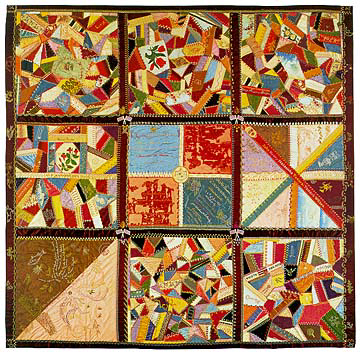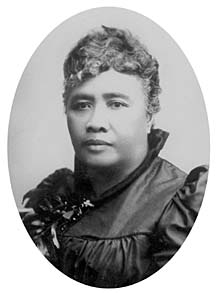Star Bulletin, Monday, March 10, 2003
By Tim Ryan
tryan@starbulletin.com

|
The center square of Lili'uokalani's quilt includes the embroidered words "Imprisoned at Iolani Palace ... We began the quilt here ..." The words begin a political statement on events that led to the queen's imprisonment. |
||
|
|
||
|
The piece, done in the crazy quilt style, documents Lili'uokalani's imprisonment |
||
| Set in a Plexiglas case in Queen
Lili'uokalani's "prison" room in the makai-Diamond Head second-floor corner
of Iolani Palace is one of the most significant pieces in Hawaiian history,
and, perhaps, the most emotionally appealing.
Although the palace tour allows visitors to view the quilt, a quick glance doesn't provide enough time to grasp its rich history. The Friends of Iolani Palace hope to change that with the eventual publishing of a manuscript written by historians Rhoda Hacker and Loretta Woodard, containing color photos of the quilt and individual patches. But first, the Friends need to raise $15,000 for printing costs. The organization is nearly halfway there with a $7,000 donation from Agnes Conrad, the book's fact-checker. The authors say the quilt was sewn by Lili'uokalani and her companions during her palace imprisonment. According to the authors, the Queen's Quilt demonstrates "all the best features" of the crazy quilt style: a nine-block format with center medallion separated by sashing and bound by a narrow border that "brings order and repose to the business of the kaleidoscopic color and randomly pieced irregular shapes within the individual blocks." The richly colored plain, printed and brocaded silks and ribbons incorporated into the quilt are believed to be from the queen's wardrobe and that of her retainers. Appliquéd to a muslin backing, every seam is "exquisitely" embroidered in "crazy stitches," the authors said, continuing to describe the work done "in multicolored silk threads and further embellished with ink, painting and a profusion of embroidered flora and fauna." Some of the items stitched on the quilt include a silk brocade figure of the mythical phoenix, a bird said to represent good fortune; an embroidered pocket watch with Roman numerals; a helmet of the Queen's guard uniform; and a pueo, or owl. PALACE OFFICIALS decline to estimate the value of the quilt. The piece "is priceless, certainly its historical value," said Deborah Dunne, palace executive director. Don Severson, owner of Hawaiian Antiquities, agrees with Dunne. "But on the open market at auction, all it takes is two people who want it and not want another person to own it," Severson said. "Under certain circumstances, the queen's quilt might sell for $100,000 or more." He cited a recent auction in which an 1800s vintage koa chest that he appraised at $10,000 to $15,000 sold for $35,000 after two parties got into a bidding war. "That doesn't mean the chest is worth $35,000," Severson said. "If I had that chest in my store priced that much, it just wouldn't sell." Within the quilt's center patches, believed to have been created by Lili'uokalani, are stitched messages documenting the most significant events of her life: "Imprisoned at Iolani Palace ... We began the quilt here"; and "Queen's Garden" and "Oct. 11, 1894," the date the garden was planted in Pauoa Valley by her supporters. The authors believe the message embroidered in the center block shows the quilt began as a needlework piece, becoming, after her imprisonment, "a fervent political statement" by the time was quilt was completed. Surrounding the Kalakaua coat of arms and framed by pairs of crossed Hawaiian flags, the center block outlines the sequence of events that changed the course of Hawaiian history, including the stitched date the Provisional Government was put in place, when Lili'uokalani was forced to step down, and the date of the aborted Wilcox revolution that precipitated the queen's arrest. Names appear in some blocks, including the Wilson-Townsend family members, close supporters of the queen, as well as names of supporters and friends. There are also commemorative and patriotic ribbons and badges, which the authors say further shows the decorative quilt served "a larger purpose as a political document." The frail quilt is made of silk and cotton, polychrome silk embroidery threads, polychrome paint and silk-screened commemorative ribbons and hat bands, with printed cotton muslin interlining. Embroidered dates indicate the quilt was completed after Lili'uokalani's release in September 1895. Lili'uokalani died of a stroke in 1917 in Honolulu at the age of 79. After the queen's death, the quilt was eventually came into the possession of Harriet Beamer Magoon, longtime secretary to Honolulu Mayor John Henry Wilson. In 1978, an anonymous donor gave the quilt to the Friends of Iolani Palace. |
||
|
|
|
|
|
|
||
| History | Atlas | Culture | Language | Links |
 The patchwork crazy quilt known as the Queen's Quilt --
created in the fashion of its era -- is a 97-by-95-inch, nine-panel cover
that documents Lili'uokalani's 10 months as a prisoner at Iolani Palace in
1895.
The patchwork crazy quilt known as the Queen's Quilt --
created in the fashion of its era -- is a 97-by-95-inch, nine-panel cover
that documents Lili'uokalani's 10 months as a prisoner at Iolani Palace in
1895.